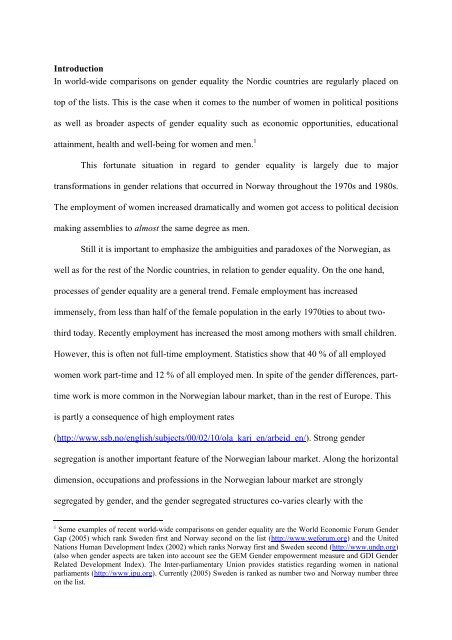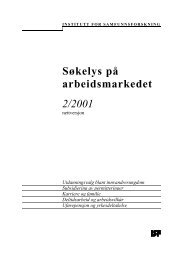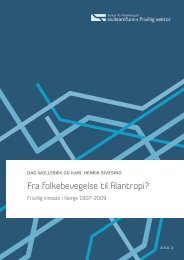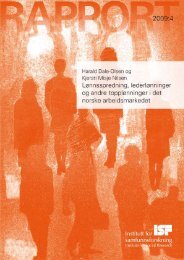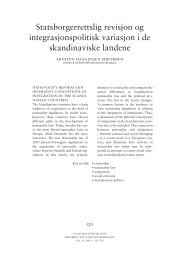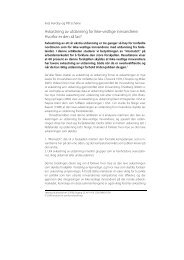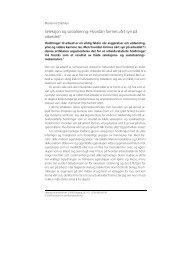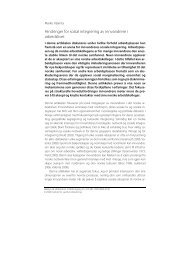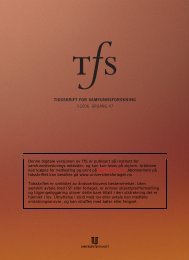Women in decision-making: The Norwegian Paradox
Women in decision-making: The Norwegian Paradox
Women in decision-making: The Norwegian Paradox
You also want an ePaper? Increase the reach of your titles
YUMPU automatically turns print PDFs into web optimized ePapers that Google loves.
Introduction<br />
In world-wide comparisons on gender equality the Nordic countries are regularly placed on<br />
top of the lists. This is the case when it comes to the number of women <strong>in</strong> political positions<br />
as well as broader aspects of gender equality such as economic opportunities, educational<br />
atta<strong>in</strong>ment, health and well-be<strong>in</strong>g for women and men. 1<br />
This fortunate situation <strong>in</strong> regard to gender equality is largely due to major<br />
transformations <strong>in</strong> gender relations that occurred <strong>in</strong> Norway throughout the 1970s and 1980s.<br />
<strong>The</strong> employment of women <strong>in</strong>creased dramatically and women got access to political <strong>decision</strong><br />
mak<strong>in</strong>g assemblies to almost the same degree as men.<br />
Still it is important to emphasize the ambiguities and paradoxes of the <strong>Norwegian</strong>, as<br />
well as for the rest of the Nordic countries, <strong>in</strong> relation to gender equality. On the one hand,<br />
processes of gender equality are a general trend. Female employment has <strong>in</strong>creased<br />
immensely, from less than half of the female population <strong>in</strong> the early 1970ties to about twothird<br />
today. Recently employment has <strong>in</strong>creased the most among mothers with small children.<br />
However, this is often not full-time employment. Statistics show that 40 % of all employed<br />
women work part-time and 12 % of all employed men. In spite of the gender differences, parttime<br />
work is more common <strong>in</strong> the <strong>Norwegian</strong> labour market, than <strong>in</strong> the rest of Europe. This<br />
is partly a consequence of high employment rates<br />
(http://www.ssb.no/english/subjects/00/02/10/ola_kari_en/arbeid_en/). Strong gender<br />
segregation is another important feature of the <strong>Norwegian</strong> labour market. Along the horizontal<br />
dimension, occupations and professions <strong>in</strong> the <strong>Norwegian</strong> labour market are strongly<br />
segregated by gender, and the gender segregated structures co-varies clearly with the<br />
1 Some examples of recent world-wide comparisons on gender equality are the World Economic Forum Gender<br />
Gap (2005) which rank Sweden first and Norway second on the list (http://www.weforum.org) and the United<br />
Nations Human Development Index (2002) which ranks Norway first and Sweden second (http://www.undp.org)<br />
(also when gender aspects are taken <strong>in</strong>to account see the GEM Gender empowerment measure and GDI Gender<br />
Related Development Index). <strong>The</strong> Inter-parliamentary Union provides statistics regard<strong>in</strong>g women <strong>in</strong> national<br />
parliaments (http://www.ipu.org). Currently (2005) Sweden is ranked as number two and Norway number three<br />
on the list.


